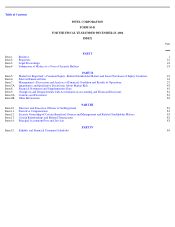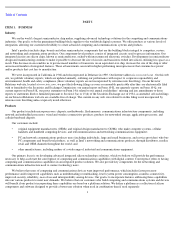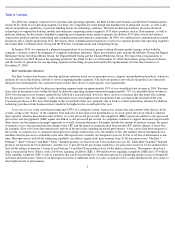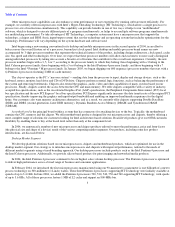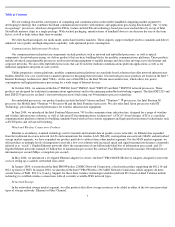Intel 2004 Annual Report Download - page 13
Download and view the complete annual report
Please find page 13 of the 2004 Intel annual report below. You can navigate through the pages in the report by either clicking on the pages listed below, or by using the keyword search tool below to find specific information within the annual report.
Table of Contents
We perform a substantial majority of our design and development of semiconductor components and other products in the U.S. Outside
the U.S., we have been increasing our product development, and we have activities at various locations, including Israel, India, Malaysia, China
and Russia. We also maintain R&D facilities in the U.S. that are focused on developing and improving manufacturing processes, as well as
facilities in the U.S., Malaysia and the Philippines that are dedicated to improvements in assembly and test processes.
We are focusing our R&D efforts on delivering the next generation of microprocessors and on the advancement of our manufacturing
process technology. Future generations of our microprocessors are expected to feature two or more processor cores on a single chip, rather than
just one microprocessor core. These dual
- and multi-core processors are expected to complement our efforts to enable more capabilities,
performance and flexibility for users beyond processor speed. Our leadership in silicon technology has allowed us to continue to deliver on the
promise of “Moore’s Law” (doubling the number of transistors on a chip every couple of years), and also to help expand Moore’s Law, by
bringing new capabilities into silicon and producing new products optimized for a wider variety of applications. We are currently
manufacturing the majority of our microprocessors using 90-nanometer process technology. Our 65-nanometer process technology is currently
in development, and we expect to begin manufacturing products using 65-nanometer process technology in 2005. We are also working to
increase the size of the cache memory in our microprocessor products. Larger cache memory allows for faster system performance at
equivalent processor speeds by allowing faster data retrieval for applications that can effectively use additional cache memory.
In addition, we believe that system security and reliability features at the hardware level will facilitate an enhanced computing experience
for users, and we are working to provide these capabilities in future products. In line with these efforts, in January 2005, we announced that we
are accelerating the introduction of our technology code-named “Vanderpool” for desktop platforms. Vanderpool is a virtualization technology
that allows a platform to run multiple operating systems and applications in independent partitions, and will complement our upcoming
introduction of dual-core processors later in 2005. To take advantage of the benefits of Vanderpool, a computer system must have a
microprocessor that supports the technology, a chipset and BIOS that use the technology, an operating system that includes optimizations for
the technology and software applications enabled for the technology. Some of these other features and applications are currently being
developed by third parties.
We also have R&D initiatives in the wireless, networking and communications product areas. Our communications initiatives are focused
on delivering the technologies that will enable an advanced wireless platform, including 802.16 products (WiMax). WiMax is a wireless
broadband access technology that is expected to enable broadband wireless access as an alternative to existing “last mile” methods such as
cable and digital subscriber lines (DSL).
We do not expect that all of our product development projects will result in products that are ultimately released for sale. We may
terminate product development before completion or decide not to manufacture and sell a developed product for a variety of reasons. For
example, we may decide that a product might not be sufficiently competitive in the relevant market segment, or for technological or marketing
reasons, we may decide to offer a different product instead.
Our expenditures for R&D were $4.8 billion in fiscal 2004, $4.4 billion in fiscal 2003 and $4.0 billion in fiscal 2002. We increased the
number of our employees engaged in R&D to approximately 25,000 in December 2004 compared to approximately 23,000 in December 2003.
Employees
As of December 25, 2004, we employed approximately 85,000 people worldwide, with approximately 60% of these employees located in
the U.S.
10


